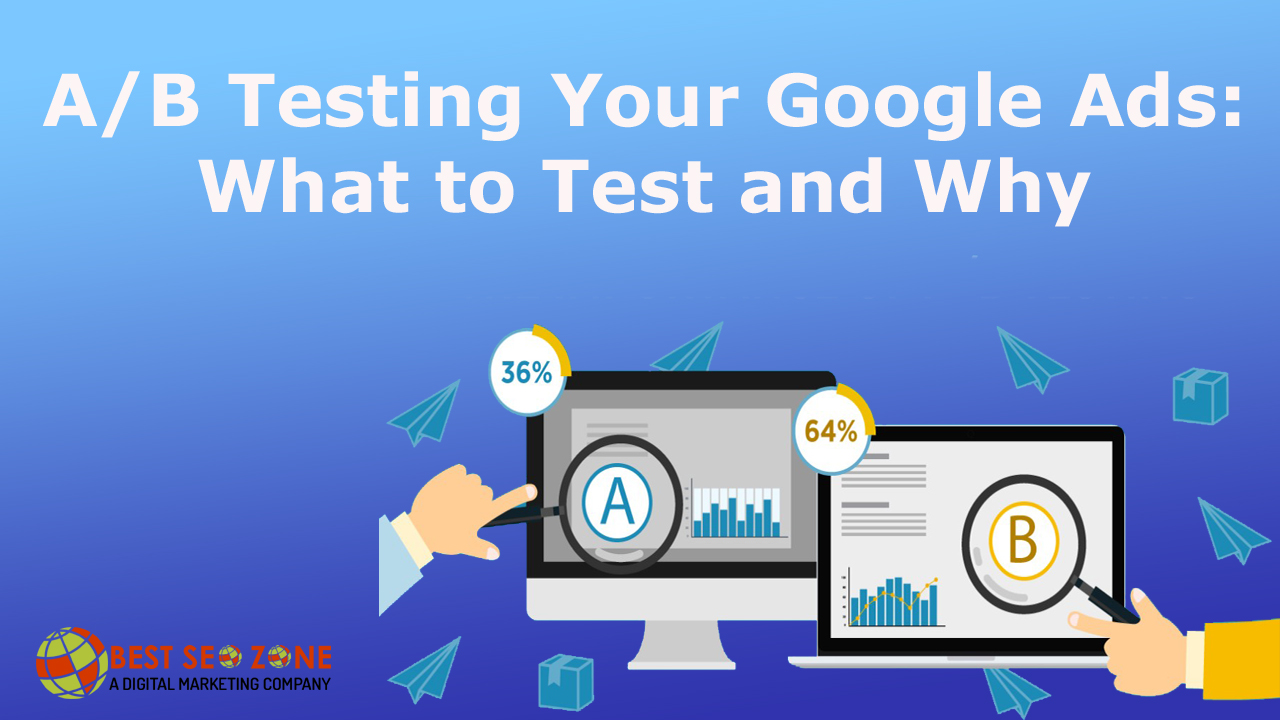Running ads on Google can feel exciting at first.You set your budget write a catchy headline and wait for the click to roll in.But after a while many advertisers realize something is missing.Some ads perform well while others fail and there is no clear explanation for the difference.That is where A/B testing comes in.
A/B testing also called split testing is the process of comparing two versions of an ad or campaign element to see which one works better.Instead of guessing you collect real data from your audience.With that data you can make smart decision that directly improve click-through rate conversions and return on investment (ROI).
In this article we will break down why A/B testing matters how you can set it up in Google Ads what to test for the biggest impact and what mistake to avoid.We will also cover advanced strategies and answer some common questions advertisers have.
Table of Contents
Why Does A/B Testing Matter for Google Ads and How It Impacts Your ROI
When running Google Ads it is tempting to assume that the ad you personally find most attractive will also work best for your audience.But in reality customers do not always respond the way we expect.A/B testing solves this problem by letting you compare two versions of an ad and see which one actually performs better with real user.Instead of relying on guesswork you make a decision backed by data.
Take this simple example one ad says Buy Shoes at 30% Off Today while another says Shop Stylish Shoes with Free Shipping.You might assume the discount is more powerful but after testing you may discover that free shipping attracts more clicks.Without running the test you would have never known which message truly resonates with your audience.
The real benefit of A/B testing lies in how it improve your return on investment (ROI).Even a small boost in performance can create big result over time.For example if your ads click-through rate increases by just 1% that can mean hundred of extra visitor every month.If even a fraction of those visitors convert into buyers your revenue grows without any increase in ad spend.
Beyond click A/B testing also helps refine the entire customer journey.You can test headlines to grab attention descriptions to encourage clicks and landing pages to secure conversions. Each improvement builds on the other multiplying the overall impact.In the long run these insights guide your future campaign ensuring your ads keep getting smarter and more cost-effective.
In short A/B testing matters because it replaces assumptions with clarity helps you spend money more wisely and steadily increases the efficiency and profitability of your Google Ad campaign.
Does Google Ads Have a Built-In Split Testing Feature or Do You Need External Tools?
One of the best parts about Google Ads is that you do not always need third-party software to run an A/B test.The platform already has a feature called Experiment.With Experiment you can
- Duplicate a campaign.
- Make a specific change like headline bid or targeting.
- Split your traffic between the original and the variation.
This way both versions run under the same conditions and you can easily compare the result.
Google also offers Responsive Search Add (RSAs).These allow you to enter multipl headlines and descriptions.Google then rotates and tests different combination to see which performs best.Although this gives less manual control it is still a powerful tool for advertiser who want quick insight without setting up a full experiment.
If you want even more advanced testing tool like Optimizely or VWO are available.These are especially useful if you want to test not just add but also landing page checkout flow or product page.However for most advertisers Google’s native testing feature are more than enough to start with.

What Elements in Google Ads Are Worth Testing for the Biggest Results
When it comes to A/B testing some element matter more than other.Here are the ones to prioritize
- Headlines These grab attention first.A strong headline can double your click-through rate.Try testing emotional vs.logical headlines or urgency vs.value-based ones.
- Descriptions This is where you convince people to click.You might test a detailed description against a shorter punchier one.
- Call-to-Action (CTA) Small wording change can make a big difference.For example Get Your Free Trial vs.Start Saving Today.
- Landing Pages Even if your ad work a weak landing page will waste click.Test page headline form length button placement and testimonial.
- Audience Targeting Sometime success come down to who see your ad.Testing by device location or demographic can reveal your most profitable segment.
Each of these areas has the potential to transform your campaign result
A Step-by-Step Guide to Running an Effective A/B Test in Google Ads
To make the process easier let walk through it step by step.
1: Start with a Hypothesis
A hypothesis is basically your educated guess.For example If I change my headline to focus on urgency my click-through rate will increase. This gives your test a clear direction.
2: Choose One Variable to Test
Keep it simple.Test only one element at a time like a headline description or call-to-action.If you test too many thing at once you won’t know what caused the change.
3: Create the Variation
Build an alternative version of your ad.If your current ad say Affordable Insurance Plan your variation might be Save Money on Insurance Today.Make sure the difference is meaningful enough to test.
4: Set Up the Experiment in Google Ads
Using the Experiments feature split your traffic evenly usually 50/50.That way both version get a fair chance.
5: Run the Test Long Enough
Do not stop too early.Let the test run for at least 2–4 weeks depending on your traffic.This ensure you gather enough data to be confident in the result.
6: Analyze and Implement the Winner
Look at key metrics like click-through rate cost per click and conversion.Once you know which version is better apply it across your campaign.
Common Mistakes Advertisers Make in Google Ads A/B Testing and How to Avoid Them
There are a few mistake that pop up again and again.The first is testing too many variables at once.If you change three thing and your ad performs better you don’t know which change actually mattered.Always keep it simple.
Another mistake is focusing only on click.A headline might drive more traffic but if those visitors do not convert the test is useless.Alway look at the bigger picture including conversion and cost per conversion.
The third mistake is ending tests too early.It is tempting to stop once one ad seem ahead but until you have enough data the difference could just be temporary.
Finally, many advertiser forget to document their result.Keeping track of what worked and what did not save time and money in the future.Every test teache you something even if the result is not what you expected.
Advanced A/B Testing Strategies for Marketers Who Want to Go Beyond the Basics
Once you nailed the fundamentals of A/B testing like testing headline descriptions or CTAs it is time to raise the bar. Advanced testing strategie can uncover deeper insight reveal hidden opportunitie and give you an edge over competitors who are still stuck at the beginner level.Think of it as moving from playing checker to playing chess. The basics still apply but the game becomes far more strategic.
Multivariate Testing for Layered Insight
While A/B testing compares two version of a single element, multivariate testing let you experiment with several element at once like testing different headlines and calls-to-action in combination.This is useful when you want to understand not just which elements work best individually but also how different parts of your ad interact together.For example a bold headline might work well only when paired with a benefit-driven CTA.The catch is that multivariate testing requires a lot more traffic to produce reliable results so it is best suited for campaigns with high impressions.
Sequential Testing for Continuous Growth
Another powerful strategy is sequential testing.Instead of testing everything at once you move step by step.First you test one element say the headline and apply the winning version. Then you take that winner and test a new variable like the description or CTA.Over time this creates a chain of improvement where each step builds on the last.It is slower than multivariate testing but it is highly reliable and easier to manage especially if your campaign does not have massive traffic volume.
Dynamic Ad Customizers for Personalization
Personalization is a game-changer in advertising and the dynamic ad customizer makes it possible at scale.With this feature you can automatically update add based on factors like location device or even time.For instance you might run a countdown ad that says Only 2 Days Left—Order Today!or tailor your message to say Free Delivery in New York for users in that area.By testing these personalized add against more generic versions you can discover whether your audience values relevancy enough to boost clicks and conversions.
Combining Ad and Landing Page Tests for Full-Funnel Optimization
One mistake many marketer make is focusing only on the ad itself.But what happens after the click is just as important.That is why advanced advertisers do not stop at ad testing; they combine it with landing page testing.For example you might run an ad with a Get Your Free Trial CTA and then test whether a short or long signup form work better on the landing page.By optimizing both the ad and the page together you create a seamless funnel that maximizes conversions from start to finish.
In short advanced A/B testing is not about adding complexity for the sake of it it is about squeezing every last drop of performance from your campaign.Whether you are layering multiple elements building improvement step by step personalizing add dynamically or optimizing the entire journey from click to conversion these strategies help you go from good results to exceptional ones.
FAQs About A/B Testing in Google Ads
Can small businesses with a limited budget run an A/B test?
Yes.Even if you do not have a big budget you can still run meaningful tests by focusing on one variable at a time and letting the experiment run longer.
Should I test ads or landing pages first?
It depends on your current challenge.If your ads are getting impressions but not clicks start with the ad copy.If clicks are coming in but conversions are low test your landing page.
How do I know if my test has enough data?
The safest approach is to aim for at least 95% statistical confidence.Google Ads often highlight when you reach this point.
What if both ads perform the same?
That is still useful information.It means the variable you tested might not influence performance much.You can move on to testing something else.
How often should I run A/B tests?
Testing should be continuous.The online market changes all the time and what works today might not work in six months.Always be testing.
Conclusion: Why Continuous A/B Testing Is the Key to Growth in Google Ads
At its core A/B testing is about learning from your audience.It shows you not just what ad work but why they work.Each test bring you closer to understanding what motivates clicks what drive conversion and what keeps your ad spend efficient.
The advertiser who succeeds on Google Add are not always the one with the biggest budget. More often, they are the ones who test learn and adapt consistently.By making A/B testing a regular part of your strategy, you ensure your campaign never goes stale your budget is always working harder and your business keeps growing in a competitive digital world.

Dilshad Mushtaq is the founder and CEO of Best SEO Zone which is a prominent digital marketing agency based in Pakistan Since 2010. He is a professional website developer & Digital Marketer who can create any website and rank it on Google Page One.




